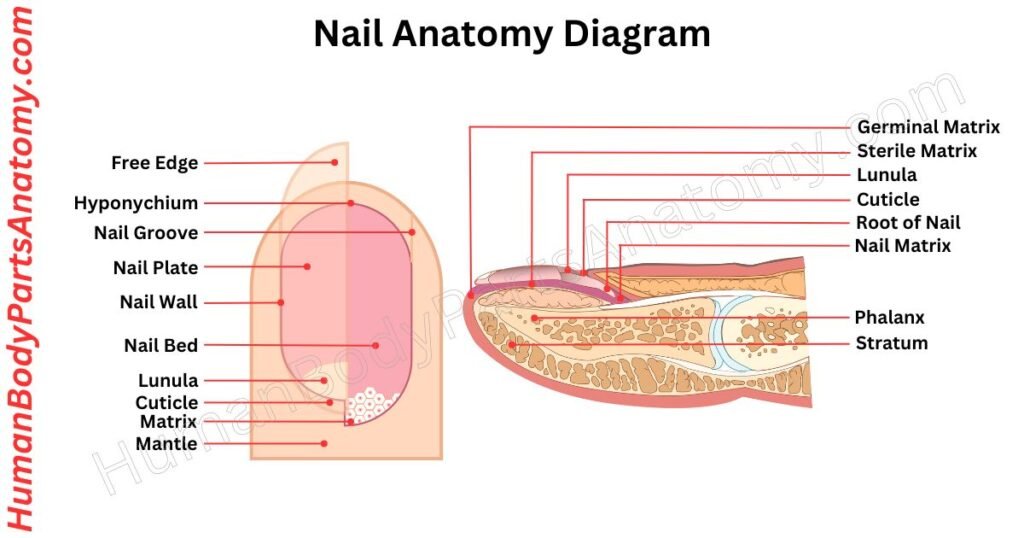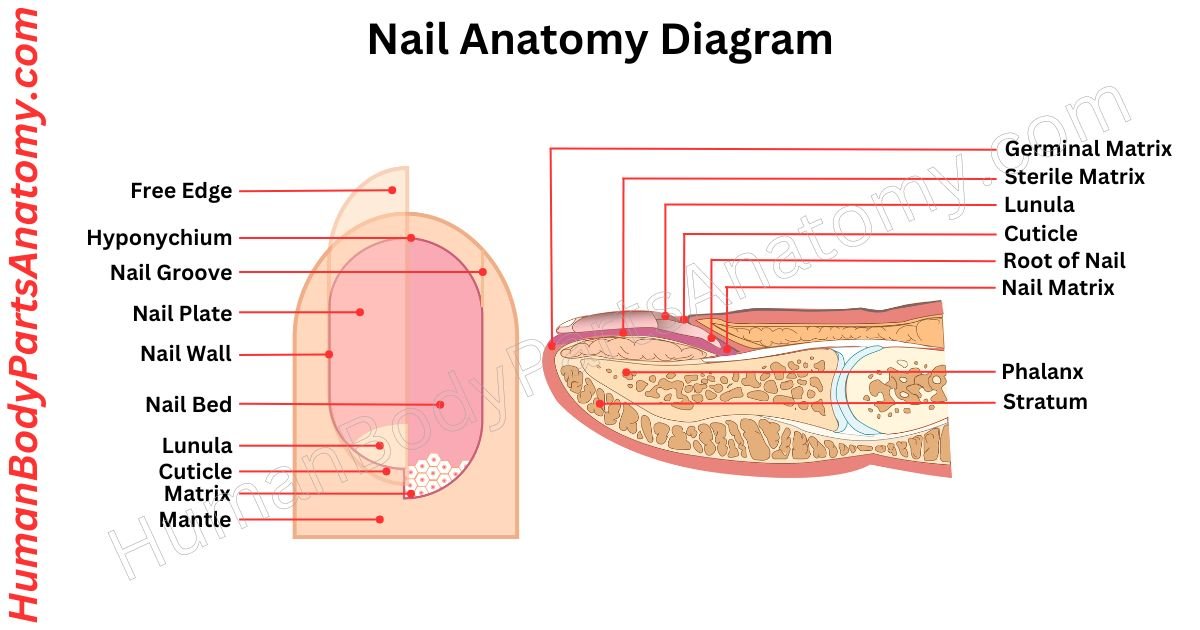Overview of Nail Anatomy
A nail is a flattish claw-like plate at the tip of the fingers and toes, which is characteristically found in all primates. They are composed of the resilient protein keratin. Nails are continuously growing and adjusting to their surroundings. They provide an essential protective shield for our fingertips. No two nails are alike. Each possesses a distinct shape, texture, and pattern that highlights the unique individuality of its owner. The nail anatomy is a masterpiece of design. It features various parts of a nail, such as the sturdy nail plate, the sensitive nail bed, the intricate matrix responsible for growth and development, and the mysterious half-moon-shaped lunula. The soft cuticle’s critical role in protecting the nail bed is a testament to the nail’s remarkable complexity and importance.
In this article, we will examine nail anatomy and its different parts and functions to get detailed information about the nails.
Nail Anatomy Diagram

Parts of the Nail
- Nail Plate
- Nail Bed
- Nail Bed Blood Supply
- Matrix
- Lunula
- Cuticle
- Nail Folds
- Nail Grooves
- Nail Root
- Eponychium
- Hyponychium
- Nail Horn
- Nail Nerves
- Nail Bed Arteries and Veins
Nail Anatomy: Parts & Functions
Nail Plate
The nail plate is a tough keratin layer that covers our fingertips. It plays a crucial role in nail treatments like applying color, gel polish, or sculpting tips.
It is okay to make it less shiny, but be careful not to file too much or take off layers. Doing this can make the nail weak, thin, and sensitive. It could compromise the natural strength and resilience of the nail.
Nail Bed
The nail bed, found beneath the nail, houses blood vessels that nourish the fingertip. Through ongoing cell generation, called oncogenesis, new nail cells are constantly produced, enabling steady nail growth.
This process safeguards the nail, defending it from external pressures while supporting its continuous development.
Nail Bed Blood Supply
One of the main parts of the nail bed is its blood supply. It comes from a complex network of tiny blood vessels. These blood vessels respond to the various stresses and strains acting on them.
When we use our fingers to do any task, the blood flow to the nail bed increases. This increase in blood flow is necessary to meet the demands of the nail matrix.
When we expose our fingers to cold temperatures, the blood vessels in the nail bed constrict. This constriction helps conserve heat and prevent damage to the surrounding tissues. A balance and other regulatory factors control this complex system of blood vessels.
Matrix
The nail matrix is a part of your nail hidden under the skin near the base. It’s split into two parts: one that starts halfway between your fingertip and nail skin and the other that forms the white half-moon shape called the lunula. It is where the hard nail is made and where cells called melanocytes, which give color, are found.
As your nail grows, special cells called onychocytes come out from the matrix and shape the nail plate. Different parts of the matrix create various parts of the nail plate. Most of the top side of the nail comes from one part of the matrix, while the bottom part comes from the other.
Lunula
The white, moon-shaped part at the bottom of your nail is called the lunula. It gets its color from living cells in your nail’s base. These cells have a special core that gives the lunula its white hue. As your nail grows, these cells weaken, and the core breaks down, making the nail see-through.
People often think the lunula’s size or presence shows how healthy your nail is, but that’s not really true. Your genetics mostly decide how big or visible your lunula is. Everyone’s lunula looks different because of their unique genes.
Some studies have suggested that the lunula could predict the risk of disease and monitor the outcome of any medical treatment.
Cuticle
The skin around your nails has a clear layer called the cuticle. It separates from the skin at the base of the nail while the nail grows. This part is not alive, so it’s usually okay to trim or file it off. Doing this can make it easier for nail polish or other nail stuff to stick better and look nicer.
Nail Folds
Nail folds are soft tissues that shield the sides and base of your nails. The base part, called the proximal nail fold, shields most of the nail’s growing area from harm and UV light.
The side parts, known as the lateral nail folds, extend from the base along the sides of the nail.
Nail Groove
Nail grooves run parallel to the nail plate on either side. It creates a natural anchor point for the nail folds. Our nails would be prone to dislodging, lifting, and detaching without them.
The size, shape, and depth of the groove vary from person to person based on genetic factors, nutrition, and health.
Nail Root
The nail root controls the entire nail’s growth and development. It is situated deep within the skin, below the proximal nail fold. It is specialized in producing the cells that make up the visible nail plate.
The nail root has exceptional regenerative capacity and constantly generates new nail cells. These cells can form a new nail plate. This process can occur in as little as six months.
The nail root is also highly adaptable to various internal and external stimuli, allowing it to adjust to environmental changes.
Eponychium
The eponychium, often mistaken as the cuticle, is the visible lip near the base of your nail. It acts as a barrier, safeguarding the nail’s growth area from harmful bacteria.
It’s alive and shouldn’t be cut. Instead, keep it hydrated and gently push it back for a neat look. Using a moisturizer regularly keeps your skin healthy around your nails. It helps your nails look nice without hurting the eponychium, which is its important job of protecting them.
Hyponychium
The hyponychium is the skin that connects your nail plate to the nail bed where the nail’s free edge starts. It’s sensitive and has lots of blood vessels. It’s important not to clean under the nail too hard with tools because it can hurt and cause bleeding.
Hurting this area can lead to pain, excessive bleeding if cut, and cause onycholysis. Onycholysis is when the nail plate separates from the nail bed, making it prone to infections and fungal issues.
Nail Horn
The nail horn is a constantly growing, tightly packed layer of keratin cells. It extends beyond the fingertips and toes.
Unlike other body parts, the nail horn is relatively insensitive to pain. Also, it plays a critical role in improving the sensitivity of the fingertips. It aids in fine motor skills such as typing, playing musical instruments, and even braille reading.
Nail Nerves
The nerves in our fingers are super important because they help us feel things really precisely. They’re like the roads that bring blood to our nails. Each finger has these nerve buddies that cover the top and bottom of the finger.
The ones on top split and go over the joint at the end of our fingers to help feel the skin near our nails. The ones underneath follow the blood path and split into smaller roads to cover the rest of the nail and the soft part at the end of our fingers.
Nail Bed Arteries & Veins
Veins and arteries present deep within the nails, which are known as the nail bed circulatory system. The primary function of these blood vessels is to transport vital nutrients and oxygen to the nail bed.
Read More-
Lower Limb
- Complete Guide on Leg Anatomy with Parts, Functions & Diagram
- Complete Guide to Thigh Muscle Anatomy: Learn Parts, Names & Diagram
- Knee Anatomy: Complete Guide to Parts, Names, Functions & Diagram
- Femur Anatomy: Complete Guide with Parts, Names, Functions & Diagram
Upper Limb
- Comprehensive Guide to Arm Anatomy: Parts, Names & Diagram
- Comprehensive Guide to Hand Anatomy: Parts, Functions & Diagram
- Shoulder Anatomy: Ultimate Guide to Parts, Names, Functions & Diagram
- Complete Guide to Finger Anatomy with Parts, Names, Functions & Diagram
- Wrist Anatomy: Ultimate Guide to Parts, Names, Functions & Diagram
- Complete Guide to Nail Anatomy with all Parts, Names & Diagrams
Human Head
- Ultimate Guide to Eye Anatomy: Parts, Structure, Functions & Diagram
- Tongue Anatomy: Complete Guide with Parts, Names, Functions & Diagram
- Mouth Anatomy: Complete Guide with Parts, Names, Functions & Diagram
- Complete Guide to Tooth Anatomy: Learn Parts, Names & Diagram
- Ultimate Guide to Ear Anatomy: Parts, Structure, Functions & Diagram
External Sources-
- Wikipedia
- KenHub
- Optometrists
- Cleveland Clinic
- American Academy of Ophthalmology

